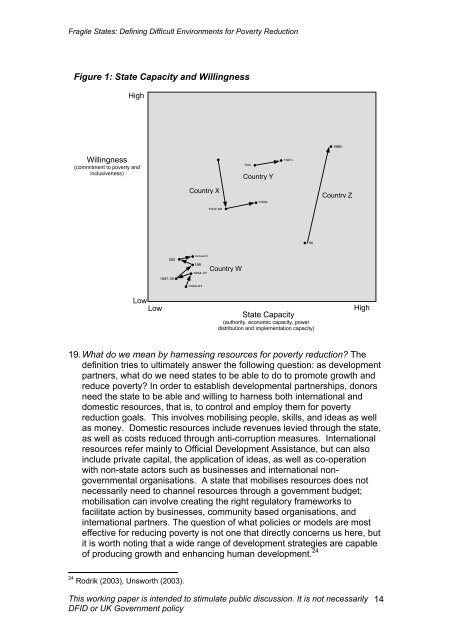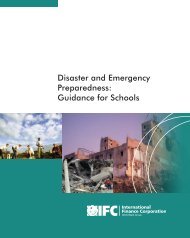Fragile States: Defining Difficult Environments for Poverty ... - INEE
Fragile States: Defining Difficult Environments for Poverty ... - INEE
Fragile States: Defining Difficult Environments for Poverty ... - INEE
You also want an ePaper? Increase the reach of your titles
YUMPU automatically turns print PDFs into web optimized ePapers that Google loves.
<strong>Fragile</strong> <strong>States</strong>: <strong>Defining</strong> <strong>Difficult</strong> <strong>Environments</strong> <strong>for</strong> <strong>Poverty</strong> ReductionFigure 1: State Capacity and WillingnessHighWillingness(commitment to poverty andinclusiveness)199Country YCountry X1997-981986-1991-1999-Country Z198LowLow2001997-98present1991994-971989-93Country WState Capacity(authority, economic capacity, powerdistribution and implementation capacity)High19. What do we mean by harnessing resources <strong>for</strong> poverty reduction? Thedefinition tries to ultimately answer the following question: as developmentpartners, what do we need states to be able to do to promote growth andreduce poverty? In order to establish developmental partnerships, donorsneed the state to be able and willing to harness both international anddomestic resources, that is, to control and employ them <strong>for</strong> povertyreduction goals. This involves mobilising people, skills, and ideas as wellas money. Domestic resources include revenues levied through the state,as well as costs reduced through anti-corruption measures. Internationalresources refer mainly to Official Development Assistance, but can alsoinclude private capital, the application of ideas, as well as co-operationwith non-state actors such as businesses and international nongovernmentalorganisations. A state that mobilises resources does notnecessarily need to channel resources through a government budget;mobilisation can involve creating the right regulatory frameworks tofacilitate action by businesses, community based organisations, andinternational partners. The question of what policies or models are mosteffective <strong>for</strong> reducing poverty is not one that directly concerns us here, butit is worth noting that a wide range of development strategies are capableof producing growth and enhancing human development. 2424 Rodrik (2003), Unsworth (2003).This working paper is intended to stimulate public discussion. It is not necessarilyDFID or UK Government policy14
















